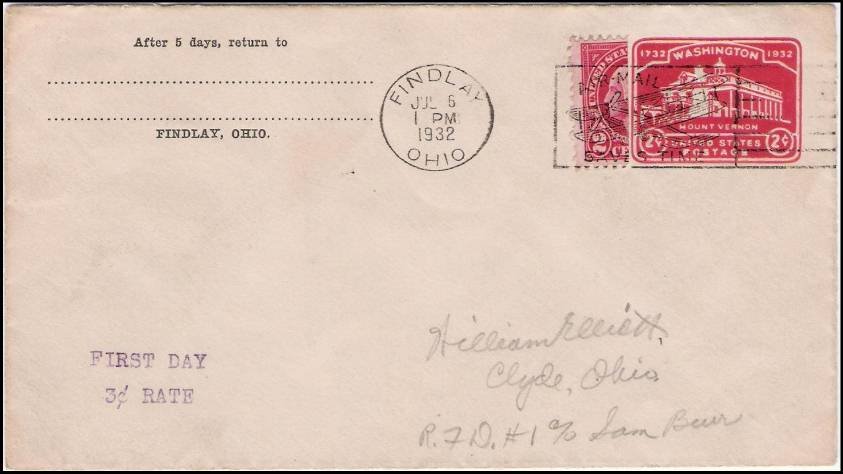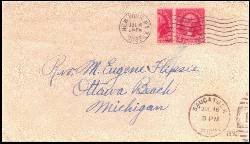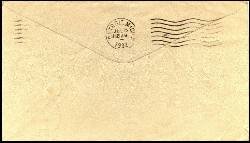

B is for Bisect |

|

|

|

|
A Bisect is a postage stamp cut in half (usually diagonally), and used to pay half its face value, e.g. half a ten cent stamp to pay five. The practice has been permitted (in the US at least) only for special situations (e.g. a shortage of stamps). The most recent of them was over 60 years ago, so genuine bisects are usually rare and valuable. There are even trisects! Note that a bisect "off cover" (or not "tied" to the cover by its cancellation) is usually worthless, since it is the proof of actual usage that makes it desirable - anyone can cut a stamp in half, but if it survives the mails that way, it becomes something special. Don't try it today - it's illegal to cut, deface or even overlap stamps on your mail.
This just in - Another collector has informed me that bisects of the Pacific 97 stamps - the 50¢ Franklin and 60¢ Washington - were officially authorized by the USPS during the show. More...
6/21/2002 - a viewer wrote to ask if his 1890's bisect might be a valid use - read our exchange HERE...
8/27/2005 - a viewer wrote to ask if his 1932 bisect might be a valid use -
read our exchange HERE...
An "ordinary" bisect
The idea of a bisect is strange to most people - one would not tear a ten dollar bill in half and use it as a five! Indeed, the practice has been permitted only in extreme cases, and mostly in the early years of stamps, in the late 1840's and early 1850's, when the procedures and mechanisms for distribution of stamps had not yet been developed - hence valid bisect usages tend to be rare and quite expensive.

The cover above, dated August, 1853, which sold at auction in 1992 for $2,310, exemplifies beautifully one of the essential characteristics of a valid bisect usage - the stamp is "tied" to the cover by the postmark/cancel, i.e. the postmark hits both the stamp and the envelope in a way that guarantees the bisect is genuine. Do people create counterfeit bisects? At prices like that, you can be sure they do. (See "Q is for Quality")
Bisect "on piece"

Bisects "on piece", like this one, are less desirable, but can still command steep prices - this one sold for $3,600 in 1995. Vertical bisects are scarcer, hence more valuable than diagonals (the catalog value of a diagonal half of this stamp - Scott #2 - on cover is $12,500, while that of a vertical half is $35,000!)
Usage denied
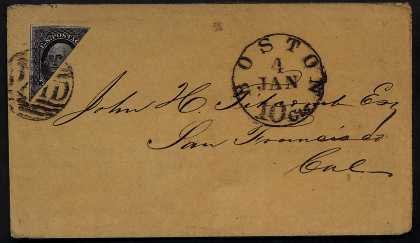
Sometimes, even though a bisect was apparently accepted by the post office on the sending end, it was refused on the receiving end - the cover above is an example. The cancellation marks it as "PAID", but the "Boston 10 cts Jan. 4" black cds due marking indicates that the addressee had to pay 10 cents - double the 5c rate - to take delivery. This cover realized $3,750+10%" in 1992.
An aristocrat of philately

The cover above (actually a folded letter) is considered one of the Gems of philately, being one of the finest quality and most visually appealing diagonal bisects known. Offered at auction in 1998, it sold for $27,500+15%. Elements that enhance its value are the use of handstamps rather than pen for the postal markings, the clear "ROXBURY" (MA) postmark, the fact that both the grid cancellation and the "5" postage mark tie the stamp to the cover, and the red ink of all the markings.
A trisect!
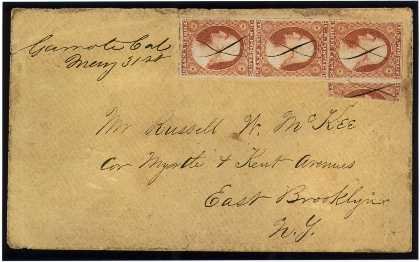
There are only sixteen known "trisect" usages. This is one of the finest, with the three 3c stamps plus part of a fourth making up the 10c rate - and the only usage in a block. It sold for $7500+10%" in 1996. The manuscript "X" cancels (See "X is for X cancel") and the fact that none of them ties any of the stamps to the cover do not seem to have detracted from the value, as the catalog value of this stamp as a bisect on cover is only (!) $5,000.
Officially issued bisects
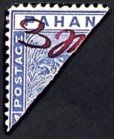

Bisects are generally worthless off cover or piece - anyone can cut a stamp in half, it is the fact that it was accepted as postage that way that makes it valuable. But in a few instances, such as the 1897 bisects of Pahang shown here, authenticated bisects off cover are collectible, because they were officially created by a post office to meet an emergency need. The one on the left sold at auction for $475+10%, the on the right for $400+10%" in 1996.
Re-united
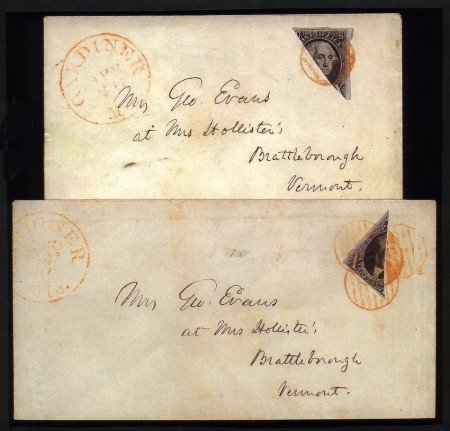
A modern bisect

The Ultimate Bisect Cover
There's no pretense of postal validity about this cover, a souvenir prepared by the author at Pacific 97. I call it my "ultimate bisect cover". One of the odder pasttimes of collectors at philatelic events is the creation of such souvenirs, though most are more conventional First Day and event covers. I had to stand in line for almost an hour just to reach the counter with this one, and then was told that the stamps, having been cut in half, were no longer postally valid, and even though the cover would never pass through the mails, it could not be cancelled! I pointed out that there was over $2.50 in postage on the envelope, and surely it would do no harm to cancel it. Twenty minutes and several levels of consultation later, I was told it could be cancelled, though not in the manner I had requested - I forget now exactly what the changes were, but was pleased with the result, as much for the commotion it caused as for the actual product.
This just in - I have just (October, 2001) been informed by a fellow collector who saw my page of Pacific 97 souvenirs that the USPS actually authorized bisects of stamps from the two USPS souvenir sheets issued at the show. He says that the slightly odd conditions were that the cuts must not separate the digits of the denominations, and the bisects were valid only during the show. So diagonal separations were ok, and horizontal separations were ok, but vertical separations (cuts from top to bottom down the middle) were not. Since I was not told about that when I submitted the cover above for cancellation, I can only presume that if this is true, the policy was revealed to the public only after the show; so if one thought to try it, one succeeded, but one never knew whether that success was a fluke or deliberate.
And this could help explain, perhaps, why my cover caused such a stir among the clerks and required a secret backstage consultation - If they had said the bisects were totally illegal, they would have been lying, while if they had told me the problem with my cover was that I had bisected the triangle stamps, they would have been revealing that the other bisects were ok. So perhaps they decided to let the cover pass as it was, and let me think the whole thing was a special favor.
Or maybe this story is just an urban myth, and no such official authorization was issued, and it was my charm and good looks that won the day.
1890's Bisect?
6/21/02 - A viewer e-mailed me as follows:
I wonder whether you have any info on bisects from later than the 1840-50s. I recently bought an accumulation of 1890s covers and found several apparently legit bisect covers therein.
I replied as follows:
Unfortunately, I cannot tell you anything specific. In general, without some documentation that a specific postmaster authorized clerks to accept bisects for some emergency, any US bisects one finds have to be interpreted as either special favors or oversight, i.e., items that should have been rejected, or at least charged postage due when delivered.
That said, I decided to refresh my memory, and looked through my library. One of the best general sources on topics like this is a book titled "Sloane's Column", published by the BIA in 1961, containing reprints of the columns of George B Sloane, a prolific and greatly respected philatelic writer of the 1930's through the 1950's. Here is the article he wrote on Bisects:
"Bisects" or "Split Provisionals," that is, stamps cut into halves or otherwise, were used from time to time by various {early US} postmasters when they found themselves with a shortage of stamps, or their stock of some denomination exhausted. They are always interesting when tied by postmark to the original cover, and philatelically valuable, particularly in the early U. S. issues, say from 1847 to the late 1860's.
But after 1869 they begin to lose conviction regardless of how well "tied" to cover. Scott, I note, lists bisected items in the issues of 1870, 1873, 1875 and 1879, but nothing later that I notice in a brief examination of the U. S. Catalog. No doubt most, if not all, of these later listings were due to genuine postal emergencies and that the postmaster in each instance was short of other stamps and had to resort to bisecting.
After 1875, however, collectors are wary of Bisects and accordingly such items find a smaller market. I have seen numerous bisected varieties in this later period that were not very convincing even though properly tied with genuine postmarks, but there was a lurking suspicion that they reflected the obliging cooperation of some postmaster in a small town. Small-town postmasters frequently violated postal instructions, not always wilfully perhaps but more often than not because of philatelic inspiration and ignorance of the regulations. Stamp collecting in the 1870's had grown to a hobby of wide popularity and there were many collectors sufficiently well informed and alert to "opportunities." Bisecting of stamps was never, to my knowledge, authorized or encouraged by the U. S. Post Office Department, though in earlier days it was to some extent "tolerated."
Bisecting was extensively practiced in foreign countries and usually under postal direction, some administrations even furnishing the stamps already surcharged with the "emergency" value for bisecting by postmasters.
July 2,1955Sloane's Column (compilation of the columns of George B Sloane), p.42, edited by G T Turner, BIA, 1961
If you want to know more, I suggest you get in touch with the American Philatelic Research Library. They will be able to tell you if anything more definitive than that has been written on the topic.
Another approach would be to talk to some knowledgeable dealers, who might at least tell you what prices they get for material such as yours.
Please let me know if you learn anything more.
Check back to see if this exchange leads anywhere.
1932 Bisect?
8/27/2005 - A viewer e-mailed me as follows:
I've been doing a bit of research on a cover I came across and would like an opinion from you as well if possible. The attached scan is a first day rate cover with bisect to make up shortage. It's 'modern,' being dated 1932, so just curious about rarity and validity. Any info would be helpful as I can't seem to find anything on the cover.
Many thanks in advance,
William Thompson
I replied:
Thanks for writing. My only expertise on bisects is what I have read, and my conclusion from what I have read is that your cover is just an accident. It should have been charged postage due, the bisect is not valid postage. The fact that it was mailed on the first day of the new rate (the First-Class, Letter, Surface per ounce rate went from 2¢ to 3¢ on July 6, 1932) leads me to suspect it was allowed out of ignorance, oversight, or courtesy, especially since it has that obviously collector-applied handstamp "FIRST DAY 3¢ RATE." Without that I might find it a little more believable. As it stands, I would call it an interesting curiosity, like a cover "franked" with a Cinderella that gets through undetected.
As for value, however, someone who collects rate-change covers might find it appealing. Again, though, the handstamp marks it as a collector creation, so that seems to me a liability.
I will add your cover and our exchange to my web page, perhaps some other collector will have something to say.
Comments, anyone?
12/20/05 - Roger T. Wolfe writes as follows:
Herewith, both the front and the reverse sides of a cover postmarked New York City and dated July 6,1932. It is franked with a full attached to a bisect of the Washington Bicentennial 2 cent stamp, Scott 707.
I continually hear that bisects have not been legitimate postage in the U.S. since the early days of stamps, and the exceptions are likely mistakes or philatelic favors. However, in this item, I find no evidence of philatelic intent, and a mistake is out of the question. Moreover, the bisect was accepted to fulfill the correct rate in New York, Detroit and Saugatuck, Michigan post offices.
It seems likely that Post Offices were caught short of 3 cent stamps at the time of the postage rate change on July 6, and in the emergency, local postmasters were forced to accept bisects as legitimate postage, and I wonder if there was an official memorandum from the Post Office Department allowing such action. But I have never seen a reference to such a memorandum in the philatelic literature. Have you?
I would appreciate your thoughts on this subject and also whether your item in Alphabetilately flushed out other specimens such as this. I wonder if it could be rare or scarce, or, as others have been adjudged, just a curiosity.
Comments, anyone?
CREDITS
No, I do not own the classic bisects illustrated on this page - I would like to thank Siegel Auction Galleries and Shreves Philatelic Galleries for their kind permission to use most of the scans above, which were taken from auction catalogs of those two firms. To see the details, place your mouse arrow over any image and let it rest there - a box with the credit for that image should pop up.
| Home | A is for Airgraph <<< | Contents | >>> C is for Cinderella stamp | Credits |
All Letter images Copyright © 1997, 2000, SF chapter of AIGA
All text Copyright © 2000, William M. Senkus
Send feedback to the webmaster: CLICK HERE
Created -- 05/01/2000
Revised -- 08/06/2025


